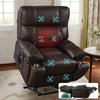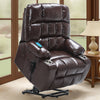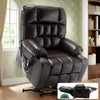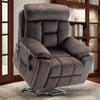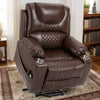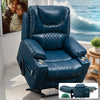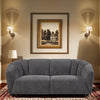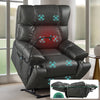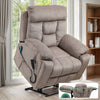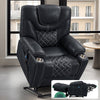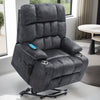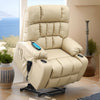Understanding Power Lifting Chairs: Functionality and Importance
The Mechanics of Power Lifting Chairs
Power lifting chairs, also known as lift recliners, are specialized chairs designed to help people stand up and sit down. They use a motorized mechanism to tilt and lift the chair. This makes it easier for users to move from a seated to a standing position.

The chair's base contains a powerful motor. When activated, it slowly raises and tilts the seat forward. This gentle motion assists the user in standing up with less effort. The reverse process helps users sit down safely.
Most lift recliners have a handheld remote control. This allows users to adjust the chair's position easily. Some models offer multiple positions, including fully reclined for relaxation.
How Power Lifting Chairs Support Lifting Efforts
Lift recliners play a crucial role in supporting individuals with mobility issues. They provide independence and safety for those who struggle with standing or sitting. This includes elderly people, those recovering from surgery, or individuals with chronic conditions.
These chairs reduce the strain on joints and muscles during the sit-to-stand motion. This is especially helpful for people with arthritis, back pain, or weak leg muscles. By assisting with this movement, lift recliners can prevent falls and injuries.
Regular use of a lift recliner can help maintain muscle strength and flexibility. It encourages users to move more often, promoting better circulation and overall health. For caregivers, these chairs make it easier to assist their loved ones, reducing the risk of injury.
Key Features to Look for in a Lift Recliner
Ergonomic Design and Comfort
When choosing a lift recliner, ergonomic design is crucial. Look for chairs that provide proper support for the back, neck, and legs. The seat should be wide enough and deep enough for comfortable seating.

Adjustable headrests and lumbar support are valuable features. They allow users to customize the chair to their body shape and size. Some models offer heat and massage functions for extra comfort and pain relief.
The upholstery material is also important for comfort. Leather is easy to clean but may not be breathable. Fabric options can be more comfortable and come in various textures. Consider moisture-wicking materials for users who tend to overheat.
Safety and Durability Considerations
Safety should be a top priority when selecting a lift recliner. Look for chairs with a sturdy base and non-slip feet. This ensures stability during the lifting process. The lifting mechanism should operate smoothly and quietly.
Many quality lift recliners have built-in safety features. These may include:
- Backup battery systems for power outages
- Emergency stop buttons
- Anti-pinch and anti-trap mechanisms
- Weight capacity indicators
Durability is also key. Choose chairs made with high-quality materials and sturdy construction. Check the weight capacity to ensure it suits the user's needs. A well-made lift recliner should last for many years with proper care.
The Importance of Quality Materials
The materials used in a lift recliner greatly affect its comfort, durability, and overall performance. High-quality materials ensure the chair can withstand regular use and maintain its functionality over time.
For the frame, look for sturdy hardwoods or metal construction. These provide better support and longevity compared to particle board or plastic frames. The lifting mechanism should be made of durable metals that can handle repeated use.
Quality padding is essential for comfort. High-density foam offers good support without breaking down quickly. Memory foam can provide extra comfort for those with pressure sensitivities. The upholstery should be both comfortable and durable.
Consider stain-resistant and easy-to-clean materials, especially for users prone to spills. Some fabrics offer antimicrobial properties, which can be beneficial in healthcare settings or for users with health concerns.
Selecting the Right Lift Recliner for Your Business or Home
Assessing Your Specific Lifting Needs
Choosing the right lift recliner starts with understanding the user's specific needs. Consider factors such as:

- The user's height and weight
- Any specific medical conditions or mobility issues
- The primary purpose of the chair (relaxation, sleeping, watching TV)
- Available space in the room
For taller users, look for chairs with higher backrests and deeper seats. Those with severe mobility issues may benefit from chairs with more powerful lifting mechanisms. Some users might need chairs that can recline fully flat for sleeping.
Consider the user's daily routine. If they spend a lot of time in the chair, extra comfort features like massage or heat may be worthwhile. For those who need frequent position changes, chairs with multiple preset positions can be helpful.
Evaluating the Cost vs. Quality of Different Brands
When it comes to lift recliners, price often reflects quality. However, the most expensive option isn't always the best fit for everyone. It's important to balance cost with the features that matter most to you.
Compare different brands and models. Look for reviews from other users, especially those with similar needs. Some well-known brands may offer better warranties or customer service. However, lesser-known brands might provide good quality at a lower price.
Consider the long-term value. A higher-quality chair may cost more upfront but could last longer and provide better support. This can lead to savings over time, especially if it helps prevent injuries or reduces the need for other assistive devices.
Installation and Maintenance Best Practices
Proper installation and maintenance are crucial for the longevity and safety of your lift recliner. Many retailers offer delivery and setup services. This can be worth the extra cost to ensure the chair is properly installed and functioning correctly.
Regular maintenance can extend the life of your lift recliner. This includes:
- Cleaning the upholstery according to manufacturer instructions
- Checking and tightening any loose screws or bolts
- Lubricating moving parts as recommended
- Inspecting the power cord and remote control for any damage
Keep the area around the chair clear to allow for smooth operation. Avoid overloading the chair with blankets or other items that could interfere with the mechanism. Follow the manufacturer's guidelines for weight limits and proper use.
By considering these factors and following best practices, you can choose a lift recliner that meets your needs and provides years of comfortable, safe use.








